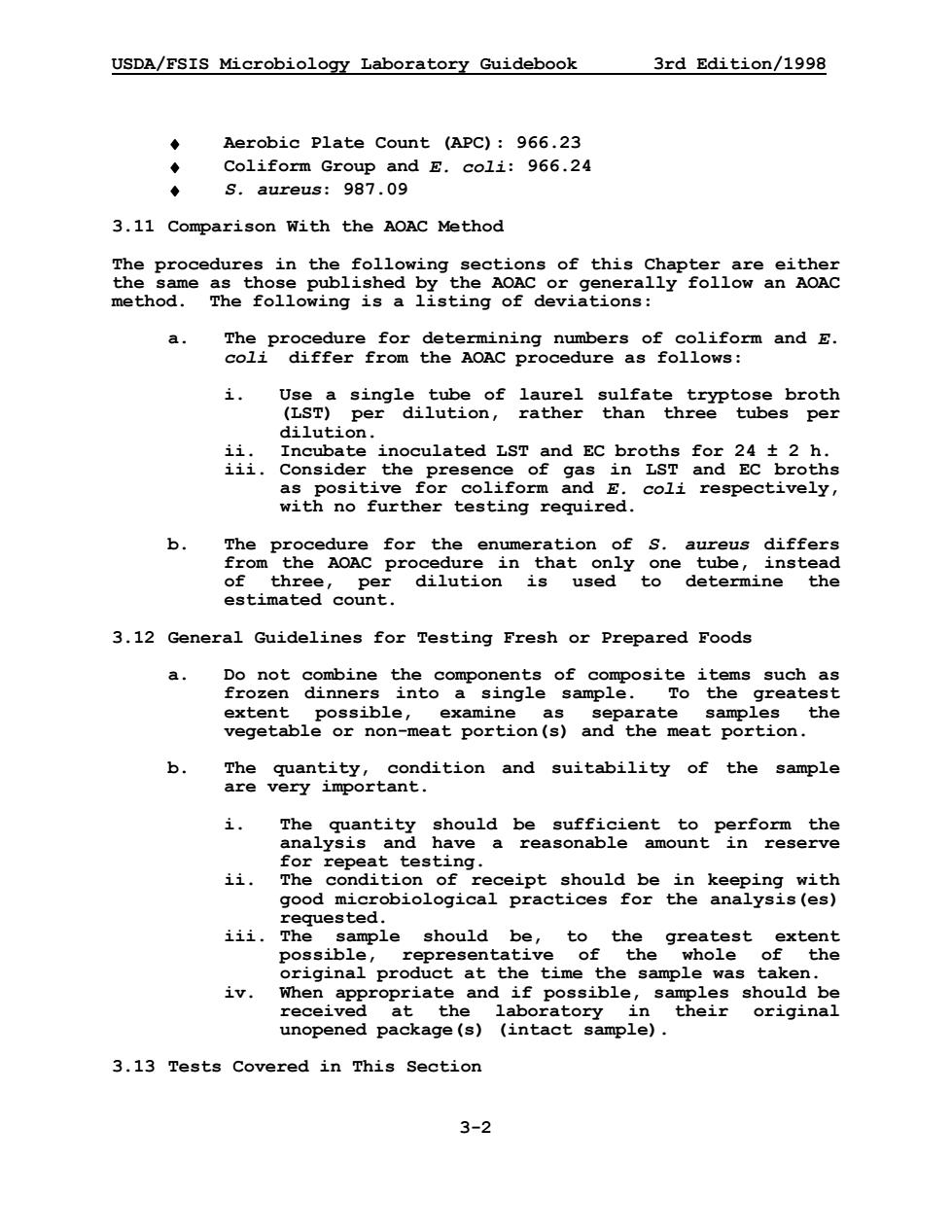
USDA/FSIS Microbiology Laboratory Guidebook 3rd Edition/1998 ◆ Aerobic Plate Count (APC):966.23 ◆ Coliform Group and E.coli:966.24 ◆ S.aureus:987.09 3.11 Comparison With the AOAC Method The procedures in the following sections of this Chapter are either method. a. ao2,Praneta2o8ateacpaoodtraagoEoaat5ananda i. dilution. Incubate inoculated LST and EC broths for 24 t 2 h. iii.Consider the presence of gas in LST and Ec broths coli respectively, b. The procedure for the enumeration of S.aureus differs the pro estimated count, 3.12 General Guidelines for Testing Fresh or Prepared Foods a. Do g11h月 To the greatest extent possible, examine as separate samples the vegetable or non-meat portion(s)and the meat portion. b. The are very important. condition and suitability of the sample 1 h qua suff: 1 ity should be perform the for a reasona amoun eat testing ii.The condition of receipt should be in keeping with good microbiological practices for the analysis(es) iii. opoavethethe the possible, original product at the time the sample was taken. iv. ae8图oea。n9e19he8:ea9 noper d package(s)(intact sar ample) 3.13 Tests Covered in This Section 3-2
USDA/FSIS Microbiology Laboratory Guidebook 3rd Edition/1998 3-2 ¨ Aerobic Plate Count (APC): 966.23 ¨ Coliform Group and E. coli: 966.24 ¨ S. aureus: 987.09 3.11 Comparison With the AOAC Method The procedures in the following sections of this Chapter are either the same as those published by the AOAC or generally follow an AOAC method. The following is a listing of deviations: a. The procedure for determining numbers of coliform and E. coli differ from the AOAC procedure as follows: i. Use a single tube of laurel sulfate tryptose broth (LST) per dilution, rather than three tubes per dilution. ii. Incubate inoculated LST and EC broths for 24 ± 2 h. iii. Consider the presence of gas in LST and EC broths as positive for coliform and E. coli respectively, with no further testing required. b. The procedure for the enumeration of S. aureus differs from the AOAC procedure in that only one tube, instead of three, per dilution is used to determine the estimated count. 3.12 General Guidelines for Testing Fresh or Prepared Foods a. Do not combine the components of composite items such as frozen dinners into a single sample. To the greatest extent possible, examine as separate samples the vegetable or non-meat portion(s) and the meat portion. b. The quantity, condition and suitability of the sample are very important. i. The quantity should be sufficient to perform the analysis and have a reasonable amount in reserve for repeat testing. ii. The condition of receipt should be in keeping with good microbiological practices for the analysis(es) requested. iii. The sample should be, to the greatest extent possible, representative of the whole of the original product at the time the sample was taken. iv. When appropriate and if possible, samples should be received at the laboratory in their original unopened package(s) (intact sample). 3.13 Tests Covered in This Section
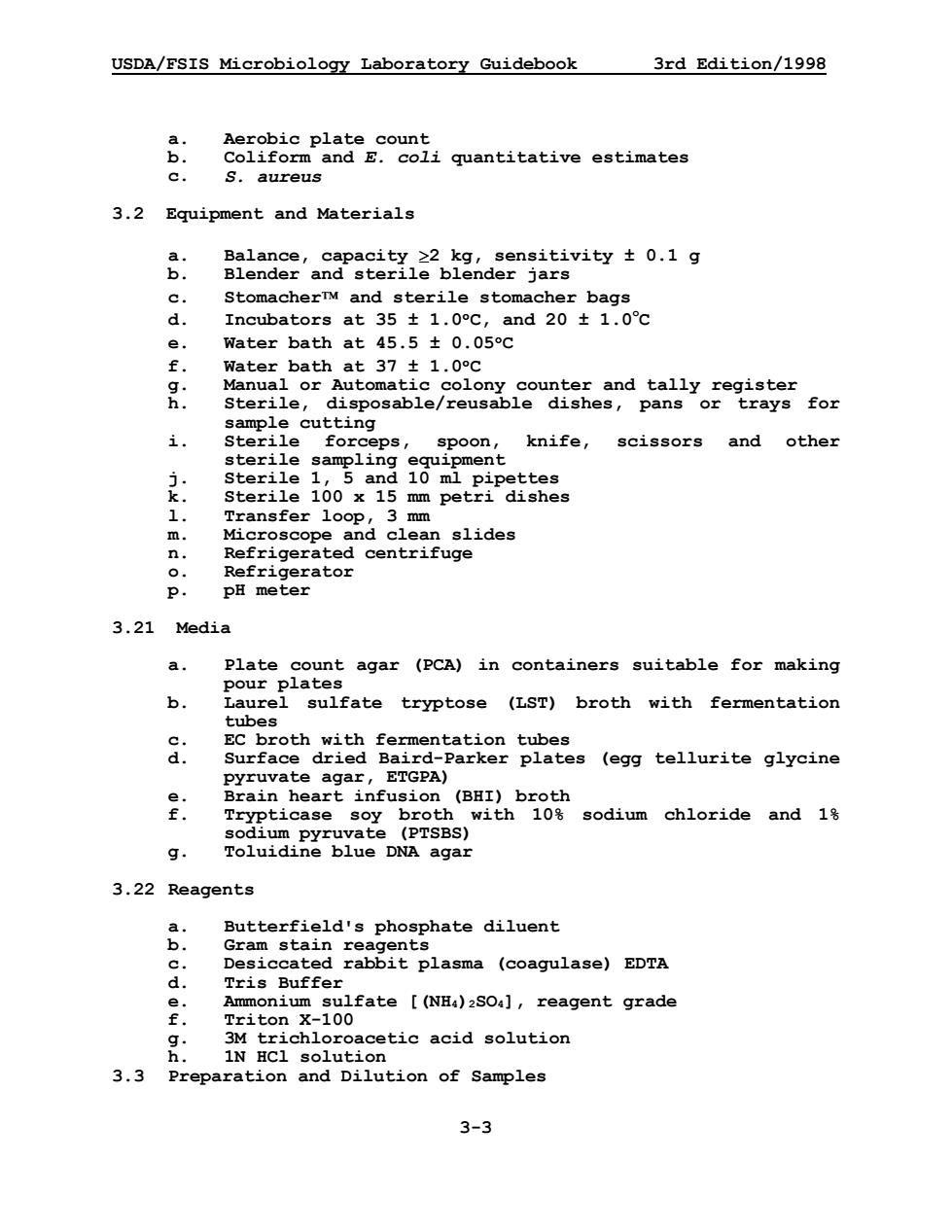
USDA/FSIS Microbiology Laboratory Guidebook 3rd Edition/1998 B. Coliform and g.coli quantitative estimates C. S.aureus 3.2 Equipment and Materials itivity±0.1g ags d O.0·T干0ZPue‘Do0I干SE4e8z01 eqnouT e. Water bath at 45.5 0.05c £ 2aoqro Water bath at37±1.0c 1e, i. for spoon】 knife, scissors and other sterile sampling equipment m Microseone and clean slides n. Refrigerated centrifuge P. 3.21 Media a. plate count agar (PCA)in containers suitable for making b Laurel sulfate tryptose (LST)broth with fermentation tubes a: EC broth with fermentation tubes Surface Parker plates (egg tellurite glycine ETGPA Brain heart infusion (BHI)broth E. Trypticase soy broth with 10%sodium chloride and 18 PTSBS) g 3.22 Reagents Butterfi eld's phosphate diluent a Desiceated rabbit plasma (coagulase)EDTA d. Tris Buffer ofate [(NH)0],reagent grade on。 h. IN HCI solution acetic acid solution 3.3 Preparation and Dilution of Samples 3-3
USDA/FSIS Microbiology Laboratory Guidebook 3rd Edition/1998 3-3 a. Aerobic plate count b. Coliform and E. coli quantitative estimates c. S. aureus 3.2 Equipment and Materials a. Balance, capacity ³2 kg, sensitivity ± 0.1 g b. Blender and sterile blender jars c. StomacherÔ and sterile stomacher bags d. Incubators at 35 ± 1.0°C, and 20 ± 1.0o C e. Water bath at 45.5 ± 0.05°C f. Water bath at 37 ± 1.0°C g. Manual or Automatic colony counter and tally register h. Sterile, disposable/reusable dishes, pans or trays for sample cutting i. Sterile forceps, spoon, knife, scissors and other sterile sampling equipment j. Sterile 1, 5 and 10 ml pipettes k. Sterile 100 x 15 mm petri dishes l. Transfer loop, 3 mm m. Microscope and clean slides n. Refrigerated centrifuge o. Refrigerator p. pH meter 3.21 Media a. Plate count agar (PCA) in containers suitable for making pour plates b. Laurel sulfate tryptose (LST) broth with fermentation tubes c. EC broth with fermentation tubes d. Surface dried Baird-Parker plates (egg tellurite glycine pyruvate agar, ETGPA) e. Brain heart infusion (BHI) broth f. Trypticase soy broth with 10% sodium chloride and 1% sodium pyruvate (PTSBS) g. Toluidine blue DNA agar 3.22 Reagents a. Butterfield's phosphate diluent b. Gram stain reagents c. Desiccated rabbit plasma (coagulase) EDTA d. Tris Buffer e. Ammonium sulfate [(NH4)2SO4], reagent grade f. Triton X-100 g. 3M trichloroacetic acid solution h. 1N HCl solution 3.3 Preparation and Dilution of Samples
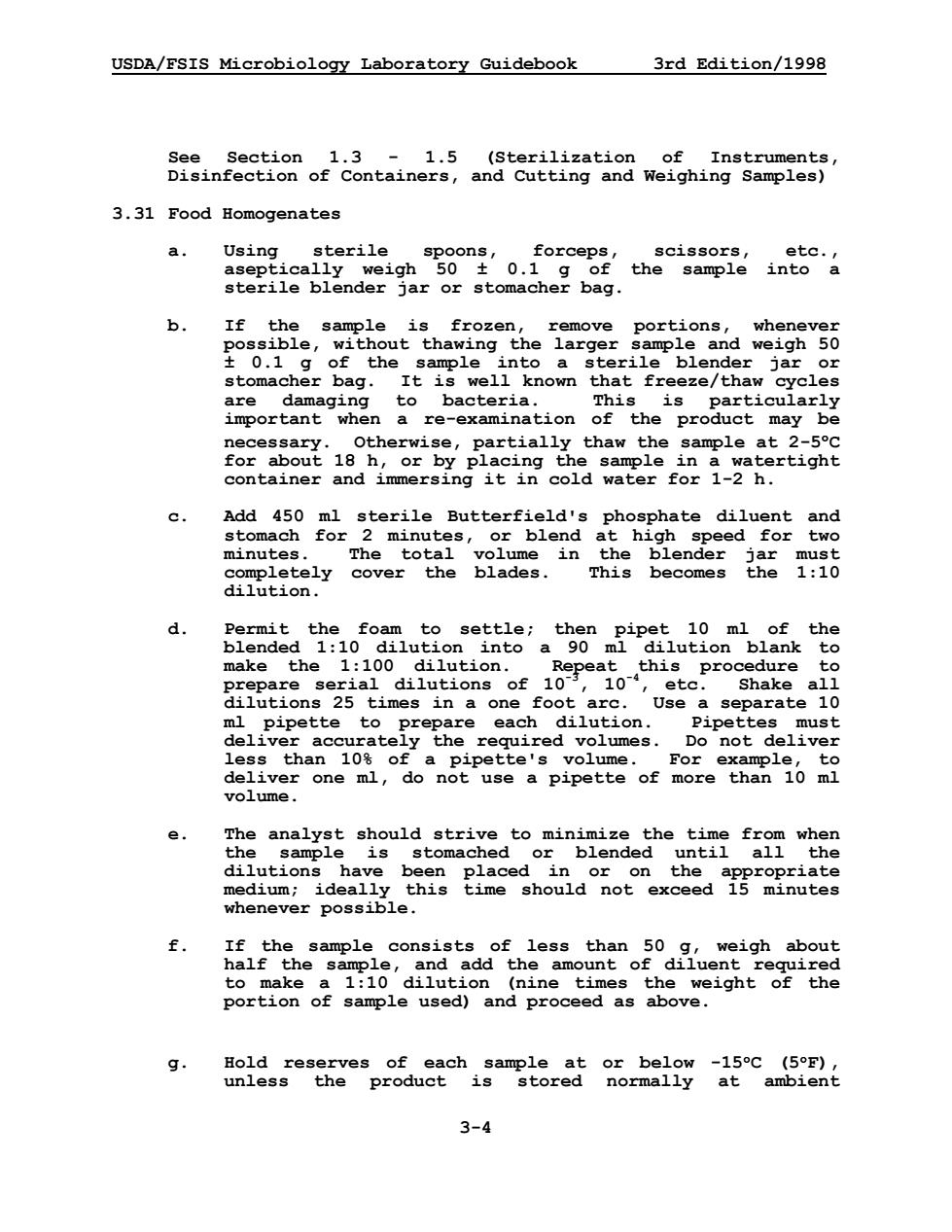
USDA/FSIS Microbiology Laboratory Guidebook 3rd Edition/1998 88iaEeomoE&3ataineanseittgtaneaghig5pies 3.31 Food Homogenates a. Using jar ag. b. If the sample is frozen, remove portions, whenever possible,with ample and weigh 50 a cles are damaging to bacteria. This is particularly important when a re-examination of the product may be necessary.Otherwise,partially thaw the sample at 2-5C for about 18 h,or by placing the sample in a watertight container and mmersing it in cold water for Add 450 ml sterile Butterfield's phosphate diluent and stomach for 2 minutes,or blend at high speed for two minutes This becomes d. Permit the foam to settle;then he:10 dilution blank 1 shake al dilutions 25 times in a one foot arc.Use a separate 10 81 pipette toeEnce cach d1t肥 Pipettes must required volumes. Do not deliver deliver one ml,do not use a pipette of more than 10 ml volume. hime should notaxcned dilutions have been placed in or on the f. mple, 6 unth producetor o Hold 11 3-4
USDA/FSIS Microbiology Laboratory Guidebook 3rd Edition/1998 3-4 See Section 1.3 - 1.5 (Sterilization of Instruments, Disinfection of Containers, and Cutting and Weighing Samples) 3.31 Food Homogenates a. Using sterile spoons, forceps, scissors, etc., aseptically weigh 50 ± 0.1 g of the sample into a sterile blender jar or stomacher bag. b. If the sample is frozen, remove portions, whenever possible, without thawing the larger sample and weigh 50 ± 0.1 g of the sample into a sterile blender jar or stomacher bag. It is well known that freeze/thaw cycles are damaging to bacteria. This is particularly important when a re-examination of the product may be necessary. Otherwise, partially thaw the sample at 2-5°C for about 18 h, or by placing the sample in a watertight container and immersing it in cold water for 1-2 h. c. Add 450 ml sterile Butterfield's phosphate diluent and stomach for 2 minutes, or blend at high speed for two minutes. The total volume in the blender jar must completely cover the blades. This becomes the 1:10 dilution. d. Permit the foam to settle; then pipet 10 ml of the blended 1:10 dilution into a 90 ml dilution blank to make the 1:100 dilution. Repeat this procedure to prepare serial dilutions of 10-3, 10-4, etc. Shake all dilutions 25 times in a one foot arc. Use a separate 10 ml pipette to prepare each dilution. Pipettes must deliver accurately the required volumes. Do not deliver less than 10% of a pipette's volume. For example, to deliver one ml, do not use a pipette of more than 10 ml volume. e. The analyst should strive to minimize the time from when the sample is stomached or blended until all the dilutions have been placed in or on the appropriate medium; ideally this time should not exceed 15 minutes whenever possible. f. If the sample consists of less than 50 g, weigh about half the sample, and add the amount of diluent required to make a 1:10 dilution (nine times the weight of the portion of sample used) and proceed as above. g. Hold reserves of each sample at or below -15°C (5°F), unless the product is stored normally at ambient
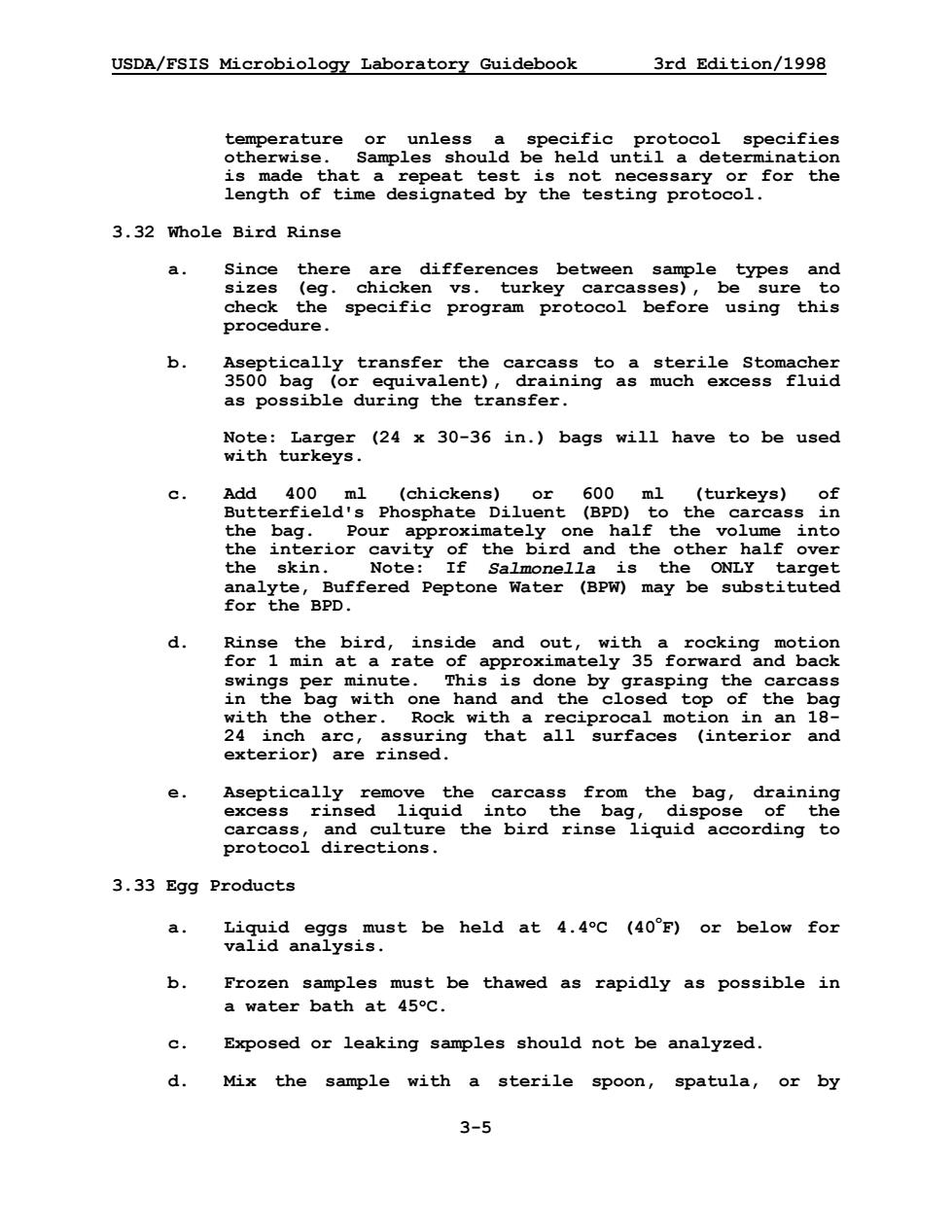
USDA/FSIS Microbiology Laboratory Guidebook 3rd Edition/1998 othehouldb heid untio is made that a repeat test is not necessary or for the length of time designated by the testing protocc 3.32 Whole Bird Rinse a. since taore chie datterences beticer ape types and Procedure. b. 3568agl%ewe,araangaate1o8s82i& t) ring the transfer Note:Larger (24 x 30-36 in.)bags will have to be used with turkeys. c. Add 400 ml 600 Butterfield's Phosphate Diluent (BPD)to the carcass in the bag. Pour the rior c 77 ove analyte, Buffered Peptone Water (BPW)may be substituted for the BPD. d. swings per minute. This is done by graspin the carcass in the bag with one hand and the closed top of the bag wit n in an 18 exterior)are rinsed ng tha at( e. draining protocol directions】 3.33 Egg Products a. dtbo held at 4.src (4o')or below ros b. Frozen samples must be thawed as rapidly as possible in a water bath at 45C. c. Exposed or leaking samples should not be analyzed. Mix the sample with a sterile spoon,spatula,or by 3-5
USDA/FSIS Microbiology Laboratory Guidebook 3rd Edition/1998 3-5 temperature or unless a specific protocol specifies otherwise. Samples should be held until a determination is made that a repeat test is not necessary or for the length of time designated by the testing protocol. 3.32 Whole Bird Rinse a. Since there are differences between sample types and sizes (eg. chicken vs. turkey carcasses), be sure to check the specific program protocol before using this procedure. b. Aseptically transfer the carcass to a sterile Stomacher 3500 bag (or equivalent), draining as much excess fluid as possible during the transfer. Note: Larger (24 x 30-36 in.) bags will have to be used with turkeys. c. Add 400 ml (chickens) or 600 ml (turkeys) of Butterfield's Phosphate Diluent (BPD) to the carcass in the bag. Pour approximately one half the volume into the interior cavity of the bird and the other half over the skin. Note: If Salmonella is the ONLY target analyte, Buffered Peptone Water (BPW) may be substituted for the BPD. d. Rinse the bird, inside and out, with a rocking motion for 1 min at a rate of approximately 35 forward and back swings per minute. This is done by grasping the carcass in the bag with one hand and the closed top of the bag with the other. Rock with a reciprocal motion in an 18- 24 inch arc, assuring that all surfaces (interior and exterior) are rinsed. e. Aseptically remove the carcass from the bag, draining excess rinsed liquid into the bag, dispose of the carcass, and culture the bird rinse liquid according to protocol directions. 3.33 Egg Products a. Liquid eggs must be held at 4.4°C (40o F) or below for valid analysis. b. Frozen samples must be thawed as rapidly as possible in a water bath at 45°C. c. Exposed or leaking samples should not be analyzed. d. Mix the sample with a sterile spoon, spatula, or by
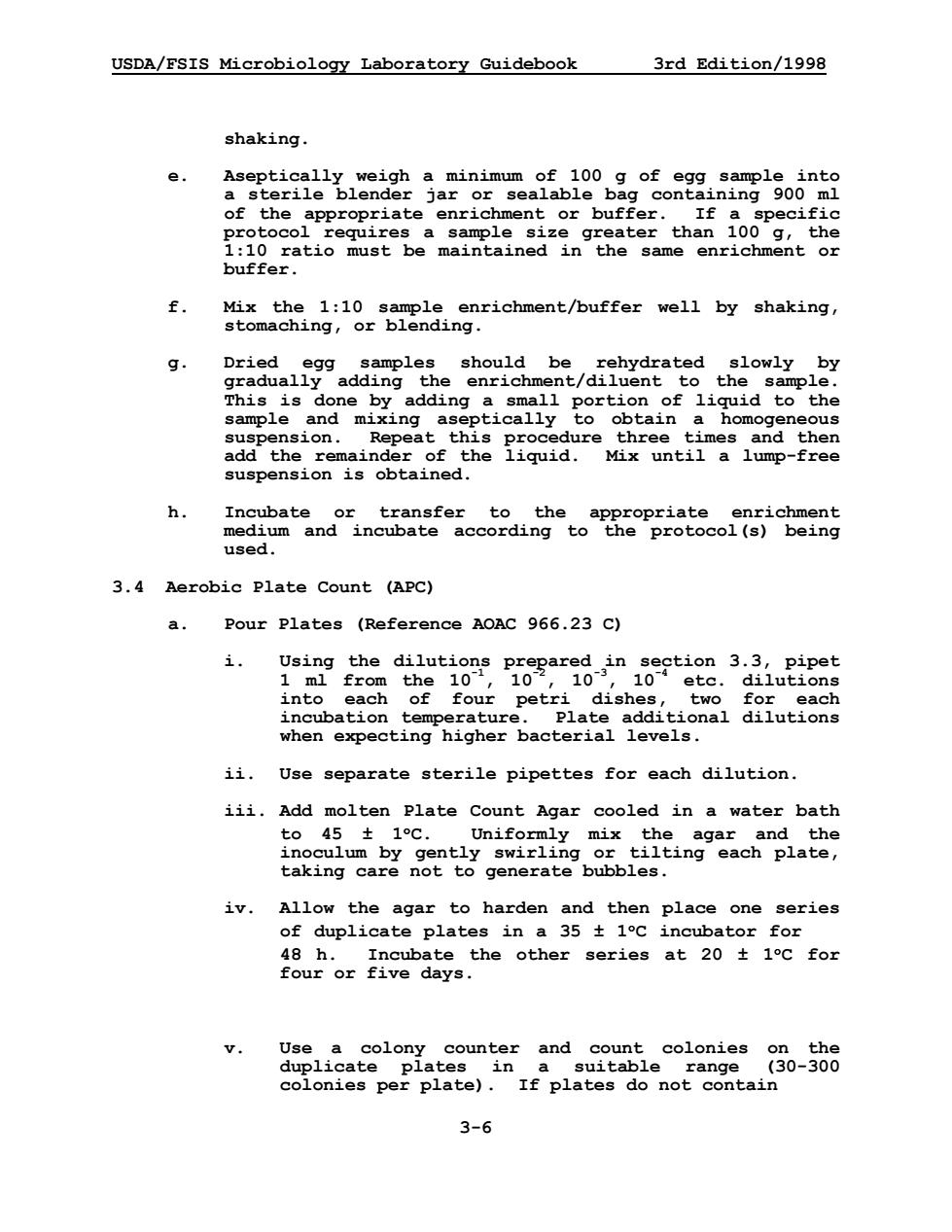
USDA/FSIS Microbiology Laboratory Guidebook 3rd Edition/1998 shaking e. of the nt or con rotham 00h ratio must be maintained in the same enrichment o fer f. Mix the 1:10 sample enrichment/buffer well by shaking, stomaching,or blending. g. This is done by adding a small portion of liquid to the sample and mixing ase ptically to obtain a homogeneous adapension.Repeat re Mi ree suspension is obtained. h. 3.4 Aerobic Plate Count (APC) a. Pour Plates (Reference AOAC 966.23 C) Using the dilutions pre 1 ml from the 10 9ar00.3品8g 10 etc.dilutions into petri dishes :two when ex cting higher pacterial levels. ii.Use separate sterile pipettes for each dilution. iii.Add molten Plate Count Agar cooled in a water bath nt]Uni irmy mix ang95oa taking care not to generate bubbles. iv.Allow the agar to harden and then place one series of duplicate plates in a 35 t 1c incubator for 48 h.Incubate the other series at 20 t 1c for four or five days. v. Use a colony counter and count colonies on the plates in range (30-300 3-6
USDA/FSIS Microbiology Laboratory Guidebook 3rd Edition/1998 3-6 shaking. e. Aseptically weigh a minimum of 100 g of egg sample into a sterile blender jar or sealable bag containing 900 ml of the appropriate enrichment or buffer. If a specific protocol requires a sample size greater than 100 g, the 1:10 ratio must be maintained in the same enrichment or buffer. f. Mix the 1:10 sample enrichment/buffer well by shaking, stomaching, or blending. g. Dried egg samples should be rehydrated slowly by gradually adding the enrichment/diluent to the sample. This is done by adding a small portion of liquid to the sample and mixing aseptically to obtain a homogeneous suspension. Repeat this procedure three times and then add the remainder of the liquid. Mix until a lump-free suspension is obtained. h. Incubate or transfer to the appropriate enrichment medium and incubate according to the protocol(s) being used. 3.4 Aerobic Plate Count (APC) a. Pour Plates (Reference AOAC 966.23 C) i. Using the dilutions prepared in section 3.3, pipet 1 ml from the 10-1, 10-2, 10-3, 10-4 etc. dilutions into each of four petri dishes, two for each incubation temperature. Plate additional dilutions when expecting higher bacterial levels. ii. Use separate sterile pipettes for each dilution. iii. Add molten Plate Count Agar cooled in a water bath to 45 ± 1°C. Uniformly mix the agar and the inoculum by gently swirling or tilting each plate, taking care not to generate bubbles. iv. Allow the agar to harden and then place one series of duplicate plates in a 35 ± 1°C incubator for 48 h. Incubate the other series at 20 ± 1°C for four or five days. v. Use a colony counter and count colonies on the duplicate plates in a suitable range (30-300 colonies per plate). If plates do not contain